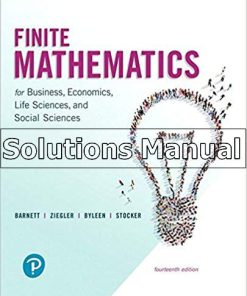College Mathematics for Business Economics Life Sciences and Social Sciences 12th Edition Barnett Test Bank
$26.50$50.00 (-47%)
In stock
College Mathematics for Business Economics Life Sciences and Social Sciences 12th Edition Barnett Test Bank.
You may also like
College Mathematics for Business Economics Life Sciences and Social Sciences 12th Edition Barnett Test Bank

Product details:
- ISBN:0321614003
- ISBN-13:9780321614001
- Author: Raymond A Barnett, Michael R Ziegler, Karl E Byleen, Michael Ziegler
Table contents:
Chapter 1 Functions and Graphs
1.1 Functions
1.2 Elementary Functions: Graphs and Transformations
1.3 Quadratic Functions
1.4 Polynomial and Rational Functions
1.5 Exponential Functions
1.6 Logarithmic Functions
Chapter 1 Summary and Review
Review Exercises
Chapter 2 Mathematics of Finance
2.1 Simple Interest
2.2 Compound and Continuous Compound Interest
2.3 Future Value of an Annuity; Sinking Funds
2.4 Present Value of an Annuity; Amortization
Chapter 2 Summary and Review
Review Exercises
Chapter 3 Systems of Linear Equations; Matrices
3.1 Review: Systems of Linear Equations in Two Variables
3.2 Systems of Linear Equations and Augmented Matrices
3.3 Gauss–Jordan Elimination
3.4 Matrices: Basic Operations
3.5 Inverse of a Square Matrix
3.6 Matrix Equations and Systems of Linear Equations
3.7 Leontief Input–Output Analysis
Chapter 3 Summary and Review
Review Exercises
Chapter 4 Linear Inequalities and Linear Programming
4.1 Linear Inequalities in Two Variables
4.2 Systems of Linear Inequalities in Two Variables
4.3 Linear Programming in Two Dimensions: a Geometric Approach
Chapter 4 Summary and Review
Review Exercises
Chapter 5 Linear Programming: The Simplex Method
5.1 The Table Method: an Introduction to the Simplex Method
5.2 The Simplex Method: Maximization with Problem Constraints of the Form …
5.3 The Dual Problem: Minimization with Problem Constraints of the Form ú
5.4 Maximization and Minimization with Mixed Problem Constraints
Chapter 5 Summary and Review
Review Exercises
Chapter 6 Logic, Sets, and Counting
6.1 Logic
6.2 Sets
6.3 Basic Counting Principles
6.4 Permutations and Combinations
Chapter 6 Summary and Review
Review Exercises
Chapter 7 Probability
7.1 Sample Spaces, Events, and Probability
7.2 Union, Intersection, and Complement of Events; Odds
7.3 Conditional Probability, Intersection, and Independence
7.4 Bayes’ Formula
7.5 Random Variable, Probability Distribution, and Expected Value
Chapter 7 Summary and Review
Review Exercises
Chapter 8 Limits and the Derivative
8.1 Introduction to Limits
8.2 Infinite Limits and Limits at Infinity
8.3 Continuity
8.4 The Derivative
8.5 Basic Differentiation Properties
8.6 Differentials
8.7 Marginal Analysis in Business and Economics
Chapter 8 Summary and Review
Review Exercises
Chapter 9 Additional Derivative Topics
9.1 The Constant E and Continuous Compound Interest
9.2 Derivatives of Exponential and Logarithmic Functions
9.3 Derivatives of Products and Quotients
9.4 The Chain Rule
9.5 Implicit Differentiation
9.6 Related Rates
9.7 Elasticity of Demand
Chapter 9 Summary and Review
Review Exercises
Chapter 10 Graphing and Optimization
10.1 First Derivative and Graphs
10.2 Second Derivative and Graphs
10.3 L’hôpital’s Rule
10.4 Curve-Sketching Techniques
10.5 Absolute Maxima and Minima
10.6 Optimization
Chapter 10 Summary and Review
Review Exercises
Chapter 11 Integration
11.1 Antiderivatives and Indefinite Integrals
11.2 Integration by Substitution
11.3 Differential Equations; Growth and Decay
11.4 The Definite Integral
11.5 The Fundamental Theorem of Calculus
11.6 Area Between Curves
Chapter 11 Summary and Review
Review Exercises
Chapter 12 Additional Integration Topics
12.1 Integration by Parts
12.2 Other Integration Methods
12.3 Applications in Business and Economics
Chapter 12 Summary and Review
Review Exercises
Chapter 13 Multivariable Calculus
13.1 Functions of Several Variables
13.2 Partial Derivatives
13.3 Maxima and Minima
13.4 Maxima and Minima Using Lagrange Multipliers
13.5 Method of Least Squares
13.6 Double Integrals over Rectangular Regions
13.7 Double Integrals over More General Regions
Chapter 13 Summary and Review
Review Exercises
Chapter 14 Markov Chains
14.1 Properties of Markov Chains
14.2 Regular Markov Chains
14.3 Absorbing Markov Chains
Chapter 14 Summary and Review
Review Exercises
People also search:
College Mathematics for Business Economics Life Sciences and Social Sciences 12th
what do you study in business economics
calculus for business economics life sciences and social sciences
queens college economics major
why mathematics is important for economics












